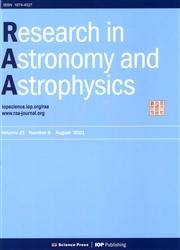近中红外光谱能量分布能否定量追踪原行星盘的演化?
IF 2.8
4区 物理与天体物理
Q3 ASTRONOMY & ASTROPHYSICS
引用次数: 0
摘要
红外光谱能量分布(SED)是原行星盘的主要示踪剂。最近有人提出利用定义在 2 到 24μm 之间的近中红外(或 K-24)SED 斜率 α 作为磁盘年龄的潜在定量示踪。我们对这一想法的可行性进行了严格的审查,并用红外亮度和 SED 形状的其他统计资料来加以证实。我们指出,由于涉及磁盘演化的大多数复杂物理因素的统计特性在定量意义上仍不甚明了,唯一可行的办法是假定它们是随机的,这样就可以定义一个理想化的 "平均磁盘",从而可以用α直方图来追踪其年龄。我们证实,观测到的 K-24 SED 的零阶(光度)、一阶(斜率 α)和二阶(凹度)特征的统计数据确实包含了 "平均圆盘 "演化过程的有用信息。我们还强调,在单个恒星的层面上,K-24 SED 的形状和亮度的内在多样性总是很大的,因此将 "平均圆盘 "的演化路径应用到单个恒星上时必须小心谨慎。图中大多数曲线的数据都在 GitHub 上提供(Disk-age 软件包 https://github.com/starage/disk-age/)。本文章由计算机程序翻译,如有差异,请以英文原文为准。
Can near-to-mid Infrared Spectral Energy Distribution Quantitatively Trace Protoplanetary Disk Evolution?
Infrared (IR) spectral energy distribution (SED) is the major tracer of protoplanetary disks. It was recently proposed to use the near-to-mid IR (or K-24) SED slope α defined between 2 and 24μm as a potential quantitative tracer of disk age. We critically examine the viability of this idea and confront it with additional statistics of IR luminosities and SED shapes. We point out that, because the statistical properties of most of the complicated physical factors involved in disk evolution are still poorly understood in a quantitative sense, the only viable way is to assume them to be random so that an idealized “average disk” can be defined, which allows the α histogram to trace its age. We confirm that the statistics of the zeroth order (luminosity), first order (slope α), and second order characteristics (concavity) of the observed K-24 SEDs indeed carry useful information upon the evolutionary processes of the “average disk”. We also stress that intrinsic diversities in K-24 SED shapes and luminosities are always large at the level of individual stars so that the application of the evolutionary path of the “average disk” to individual stars must be done with care. The data of most curves in plots are provided on GitHub (Disk-age package https://github.com/starage/disk-age/).
求助全文
通过发布文献求助,成功后即可免费获取论文全文。
去求助
来源期刊

Research in Astronomy and Astrophysics
地学天文-天文与天体物理
CiteScore
3.20
自引率
16.70%
发文量
2599
审稿时长
6.0 months
期刊介绍:
Research in Astronomy and Astrophysics (RAA) is an international journal publishing original research papers and reviews across all branches of astronomy and astrophysics, with a particular interest in the following topics:
-large-scale structure of universe formation and evolution of galaxies-
high-energy and cataclysmic processes in astrophysics-
formation and evolution of stars-
astrogeodynamics-
solar magnetic activity and heliogeospace environments-
dynamics of celestial bodies in the solar system and artificial bodies-
space observation and exploration-
new astronomical techniques and methods
 求助内容:
求助内容: 应助结果提醒方式:
应助结果提醒方式:


